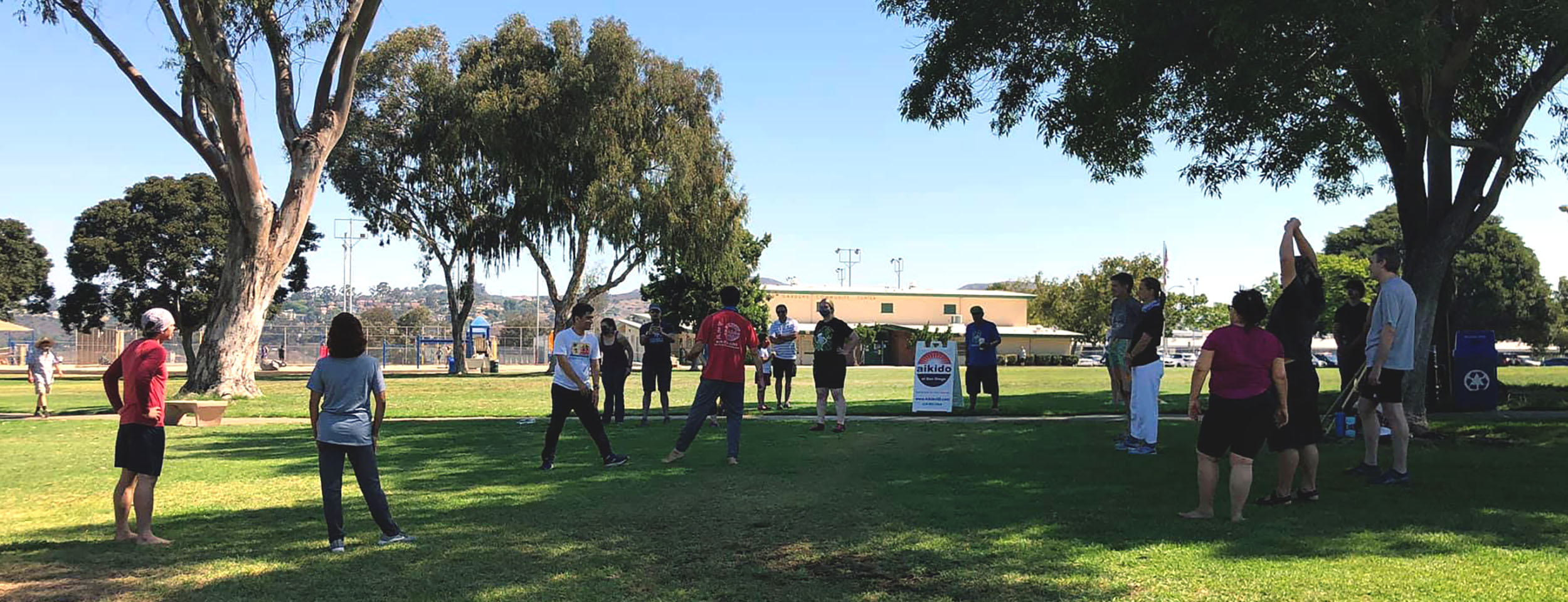This is the second part of a two-part article. The first, from May 2021, was about options for shoulder pads or padded shirts, to make rolling on hard ground safer and more comfortable. You can find it here: Outdoor Aikido Training, Part 1 — Rolling On Grass. Hard Grass.
Our training situation continues to evolve. Only those who are vaccinated may train, as we are training hands-on now. We will continue with classes in the park and on Zoom, and on Tuesdays a hybrid of both! Sensei has just leased a nice indoor practice space, so we will also have indoor classes available.
But We’re Not Done With This Pandemic Yet
Many are still wearing masks, indoors or out, given the uncertainty around transmitting the Delta variant. We’re learning more every day that could affect how we train. It’s hard to know what’s safe and what’s risky. Here is an excellent 11-minute audio report, discussing what was known as of July 30, 2021:
Scripps Research Director Weighs In On Data That Shows Vaccinated Can Spread COVID
It’s been great being able to continue training together throughout this disaster. A grounding experience when everything has been in flux. Some folks are have only been doing Zoom, but as things calmed down more members started participating in the park classes.
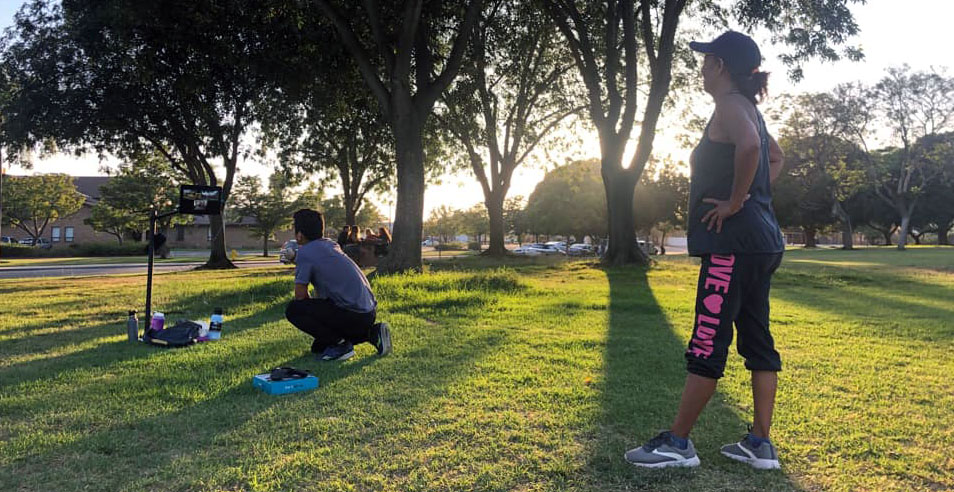
Equip Yourself to Enjoy Training Outdoors
I’ve really been enjoying outdoor Aikido training. During warmups we stretch and look up at the hummingbirds in the trees overhead. Dojo members bring their families to the park, where all the kids can run and play together while we train. Onlookers discover the art, and sometimes hang around to watch. And we all get to practice keeping our focus when adorable puppers and doggos go by on their daily walks.
There’s no limit to the space you can use in jiyuwaza and randori (freestyle practices with one or multiple attackers), and training in nature is inspiring. There have been a few challenges to overcome. Sometimes the weather is uncomfortable. The ground can be hard and uneven. Interruptions can be distracting. But on the whole it’s been a lovely experience. I imagine if our practice had been outdoors all these years, and suddenly we were told we had to only train indoors, in a room with mats and fluorescent lights, we might rebel, finding the idea constraining and disconnected.
I’ve discovered some tips and products that have really helped me, and which you might find helpful, too. I spent hours searching, reading reviews, and even trying a few things that didn’t work out. But I have not exhaustively tested or compared these solutions. I don’t know that the equipment I’ve purchased is the best out there. But they work well for me. You might find something better. Or save yourself a lot of time and just buy the items below.
The links below go to Amazon, Columbia Sportswear, eBags, and others, just for convenience. You can probably find these items elsewhere, too. These are not affiliate links. I do not get a kickback. Maybe someday I’ll bother with that. Right now these are just things I and others have used, and they work.
Wear Your Mat! Rolling and Falling on Hard, Rough Ground
I’ve already talked about my biggest challenge: How to roll on the hard ground without bruising or hurting your shoulders. You can find that article here: Aikido in the Park, Part 1 — Rolling On Grass. Hard Grass.
As I promised in that earlier post, we are back with more tips to make your training in the park more comfortable and fun.
The Basics — What To Wear
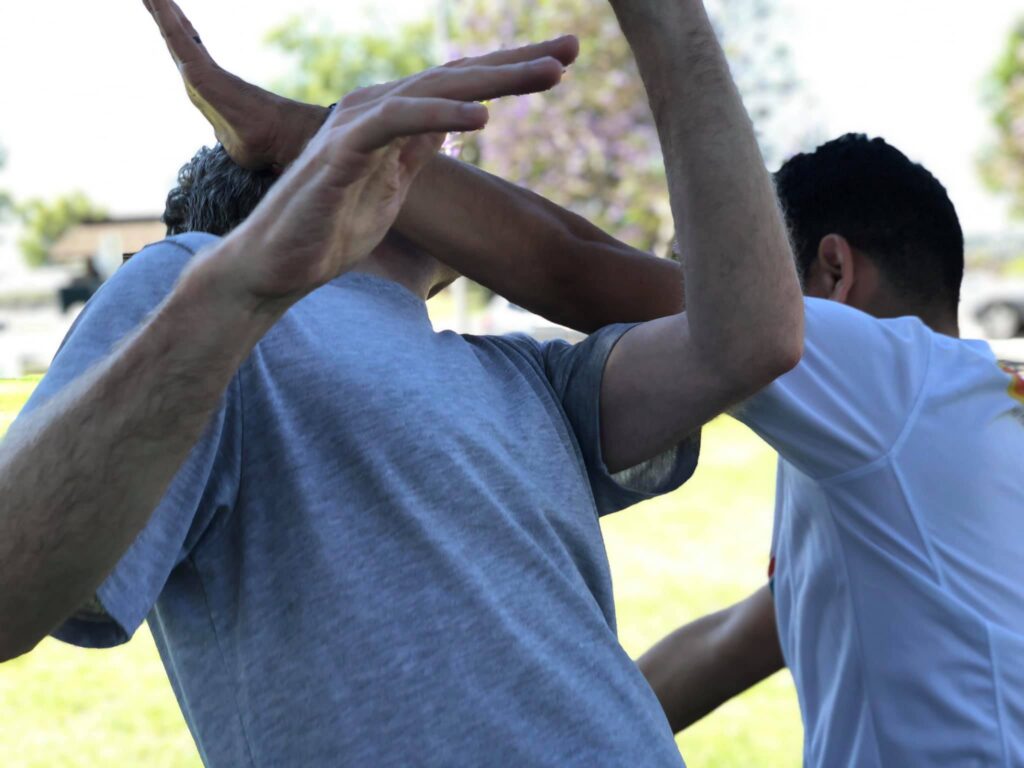
We train in street clothes — jeans and tee shirts, sweats, leggings, hiking pants, etc. — so we can wear whatever works for us.
Wear Loose-Fitting Clothes You Don’t Care About
Don’t wear your favorite leggings, new hiking shirt, or Polarfleece sweatshirt to class. Training at the park is messy. The grass can be wet from rain or watering. If the Parks folks just mowed there will be loose bits of grass everywhere. A while back there were pretty low-growing sticker plants everywhere, and when we rolled it looked like we’d fallen into a patch of burrs. We kept picking them off of each other. Finally, people let their dogs pee and poop everywhere at the park. (Gross!) Even on the best of days you’ll get dirty, or you’ll get grass stains, or both.
This Is the Time for Baggy Jeans
This is the time for those old, loose-fitting jeans you wear to work in the yard. If they have a little stretch to them, so much the better. Some of my dojo mates wear sweatpants (soft and loose), hiking pants (cool and smooth), or even shorts (cool, but no protection for your knees and lower legs). Personally, I like jeans. They are heavy enough to offer some protection, they have enough body that don’t cling to you, and the tightly-woven fabric doesn’t pick up burrs and stickers. Plus they are dark enough that a little dirt and a few stains aren’t a big deal.
Size, fit, and style will vary so much that you won’t be able to rely on my recommendation, but I bought a couple pairs of inexpensive Lee jeans early on in the pandemic — one to keep nice, and one for training and yardwork—and they’ve worked well for me.
What if You Have to Train Outdoors in Your Gi?
If your class trains in regular uniforms, keikogi, great. That’s not a bad idea at all, and it’s great for visibility. Other park users might notice your class and get interested in training! Gi are good in a few ways. First, the tightly-woven cotton fabric doesn’t collect stickers, burrs, and bits of grass as readily as knit sweatpants or tee-shirts do. They are light and loose so you can move, and keeps the sun off you. The long sleeves help protect your arms when you roll.
I’ll offer the same suggestion as for the street clothes, above: Wear a gi you don’t care about. This is the time to drag out the old ones you had semi-retired. If all you have are beautiful uniforms you special ordered from Japan, now is the time to buy something cheap that you won’t mind ruining.
Even if your class doesn’t require wearing a gi, a pair of heavy gi pants might not be a bad idea. White would be cooler, but get dirty quicker. Black could be hot in the sun, but would not show the grass stains.
I would hope instructors are not requiring hakama for outdoor training. It’s plenty challenging enough without introducing that complication.
Choose Footwear That Moves With You
You’ll want flexible shoes with little tread. Flexible so you can move freely, including falling and rolling. But why little tread? Consider how we move on the mat, sliding and turning. You don’t want your shoes sticking to the ground. If you pivot and your foot does not, the other joints in your leg will take the strain. You don’t want to wrench your knee trying to tenkan!
I wear minimalist shoes from Xero Shoes — their HFS model. Mine are men’s, because the shoe industry refuses to believe that women can have large, wide feet, but the Xero HFS shoe for women is available in cooler colors and smaller sizes.
How About Going Barefoot?
Some of our members train barefoot. I’ve tried it, and loved the feeling of being directly in contact with the ground and grass. However, there are those darned stickers. Later that day I found myself picking them out of my feet. There can also be glass, rocks, or other sharp objects on the ground at a park. Additionally, we do tend to step on each others’ feet now and then, and that’s no fun when you’re barefoot and your partner is wearing hiking shoes.
It’s up to you. I prefer shoes (even though I hate wearing shoes), but your might love training barefoot outdoors.
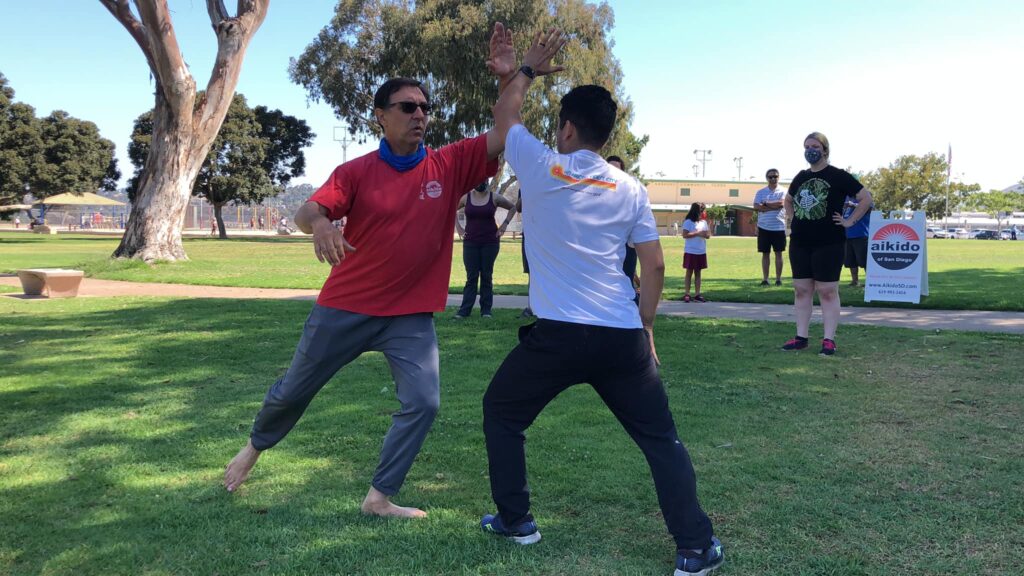
Hot Weather and Bright Sun
A Hat Comes in Handy
A big, light, floppy hat goes a long way toward keeping the sun off your face and neck while still letting you train.
A big brim keeps the sun out of your eyes, so you can see what’s being demonstrated, and off your face, so you don’t get sunburned. Mine also has a long neck cover down the back (where a brim would be), to keep the sun off my neck.
A light fabric and light color, especially with ventilation panels, will heal keep your head cool.
Floppy is important! If a hat is too stiff it will be in your way when you raise your arms during warmups, or when practicing strikes. And you don’t want it to get bent out of shape when you roll with it, or receive irimi-nage.
Choose one that includes a “stampede string,” or neck strap that under-the-chin strap that keeps it from blowing off. This obviously can help on windy days, but it can also keep you hat in place during falls and rolls. It also means you can take it off and let it hang down your back if your head gets too hot.
Be sure you select the right size. The one I use comes in several sizes and also has an adjustment strap at the back to help it fit snuggly. This is a great feature.
Here’s the one I wear, for class, and also for hiking and other outdoor activities: Adventure Hat by Sunday Afternoons. They are available in several colors, from light cream or gray to vivid pink, purple, and blue.
Training Outdoors in Cold, Wet Weather
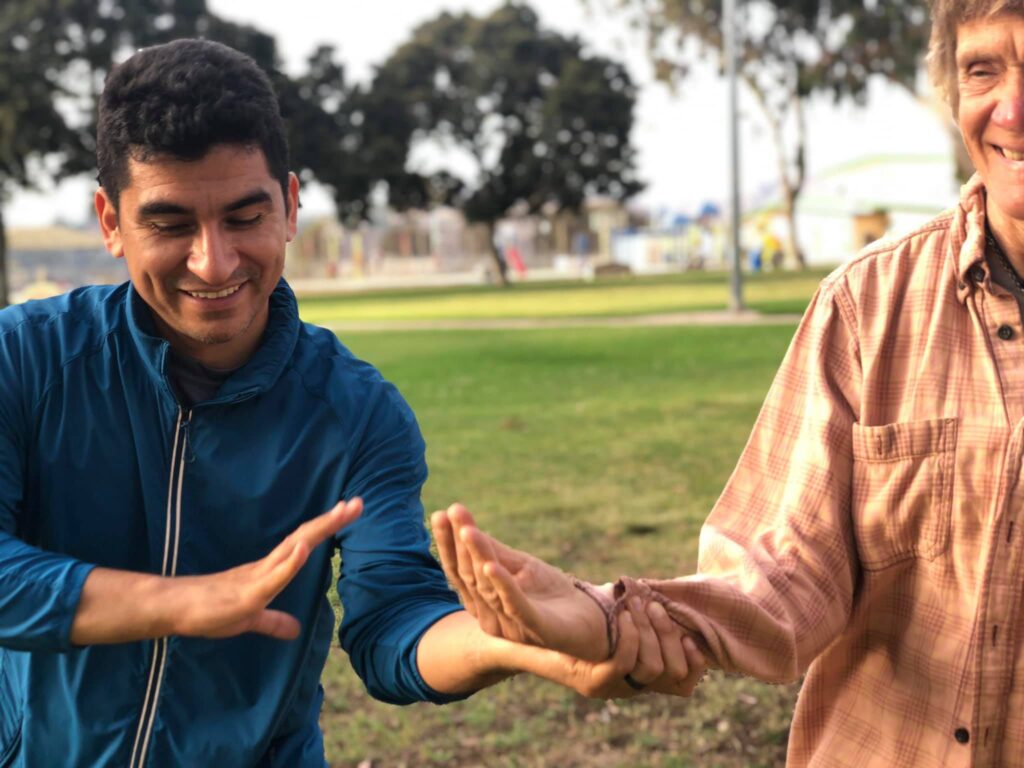
We are fortunate to be in San Diego, where the weather is hospitable year-round. We’ve had some cool days (in the 50s), and some warm days (in the 90s), and even a few rainy days. You can’t go wrong with layers. When it’s cold I wear an undershirt, and put on thin sweatpants under my jeans. You could wear thermal underwear, if you have that.
Rain Gear
Even in San Diego it rains sometimes. You will not melt. Go ahead and train! (Unless there’s lightning, of course, then go home.) Staying dry is nice, though, and an umbrella won’t work here, so you’ll need rain gear.
You’ll want something that fits well enough it will move with you, so this isn’t the time for a poncho. But you’ll need room to move, too, including bending, kneeling, and rolling. You’ll be wearing them over your regular clothes, possibly including your sweatshirt. So err on the side of getting something that’s a little too big. You can always tighten the drawstring.
Your style, size, and color preferences will vary, so it’s hard to say “buy this one,” but I found good quality, reasonably priced pants and a jacket that work for me at Columbia Sportswear. I have the Women’s Storm Surge™ Rain Pants in black (so I don’t care about dirt or grass stains), and the Women’s Arcadia™ II Rain Jacket in Buttercup (bright yellow). Gotta match my yellow car, y’ know. Both of these seem solid and well-made. I’ve trained in them several times and have been happy with their performance. Be sure to check their Clearance items!
You might want a few other things for rainy days, too. I put together a kit in an inexpensive Everest Basic Backpack in Orange, and just leave it in my car so I’m always prepared. In addition to the above rain gear I have an umbrella (not for training), and a handful of terrycloth rags for wiping down wet gear before putting it away.
Something to Put Your Stuff In (or On)
You may already have a nice dojo bag. Great! But that might not be what you need for training at the park. First, you probably don’t want to get it dirty. Second, you won’t be carrying so much stuff — no change of clothes, no hakama (I hope!), no belt. You’ll just need your water bottle, hat, sunscreen, ID, etc.
When I bring the shoulder pads mentioned above I carry them separately. They are pretty huge. I’d need a big duffle bag!
Consider bringing a small pad, towel, or blanket to sit on, and to put your stuff on. When the grass is wet I appreciate being able to sit on a dry spot to put on my shoes (which I don’t normally wear otherwise). I use a little foam pad sold in garden stores, for kneeling while weeding.
First Aid Tips for Outdoor Aikido Training
If you are in instructor, you’ll want to keep a first-aid kit handy (at least in your car), and bring hand sanitizer and maybe sunscreen for the class to use. Review the signs of heat injury: Warning Signs and Symptoms of Heat-Related Illness [US CDC]. Keep a couple of bottles of Gatorade in the car in case someone is suffering from the heat, and of course encourage students to drink water, and to rest or sit out if they are feeling overheated. See my earlier article: Your Dojo First Aid Kit for tons of first aid kit ideas. Keep in mind that article is about a first aid kit for a dojo or seminar. Consider how your needs might be different in an outdoor situation.
If you’re only participating in classes you still might want to carry a few things: BandAids, tweezers (for stickers in feet or hands), alcohol wipes, hand sanitizer, and of course any medications you might need (e.g. my Albuterol inhaler).
Have Fun Exploring Aikido in a New Environment
However you equip yourself for training outdoors, enjoy the new perspective. You will have opportunities to question and revisit everything from how you fall and roll, to the role of uniforms and formal dojo etiquette. The place of Aikido in your life may have shifted, at least for the time being. The social aspect might be more important at the moment, when having a community of trusted friends can be reassuring. Mindfully focusing on mastery of small details could help you stay centered when things around you are uncertain.
As our situation continues to change loosen your grasp on your old understanding and expectations and see what there is for you to discover now.

